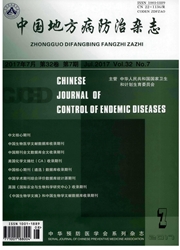

 中文摘要:
中文摘要:
目的探讨亚慢性过量氟暴露对大鼠骨组织中骨涎蛋白(BSP)表达水平的影响。方法雄性Wistar大鼠60只,体重(90±5)g,随机分为4组,对照组(饮自来水)、低氟组(饮水含氟50mgF-/L)、中氟组(饮水含氟100mgF-/L)、高氟组(饮水含氟150mgF-/L)。采用免疫组织化学法检测大鼠骨组织中骨涎蛋白的表达水平。结果在同一个染氟月份内,各染氟组的平均综合光密度值均明显高于对照组(P〈0.01);同一个染氟剂量组BSP的平均综合光密度值随着染氟时间的延长而不断升高(P〈0.01)。在同一染氟月份中,大鼠骨组织中BSP阳性表达的平均综合光密度与骨氟含量呈明显的正相关关系。结论亚慢性过量氟暴露对大鼠骨组织中骨涎蛋白表达水平有影响,各染氟组大鼠BSP的表达水平高于对照组,且BSP的表达水平与骨氟含量间存在着明显的正相关关系。推测BSP可能在慢性氟中毒的病理性骨转换过程中发挥重要的促进作用。
 英文摘要:
英文摘要:
Objective To investigate influence of subchronic exposure to excessive fluoride on the level of bone sialoprotein (BSP) expression in rat bone tissues. Methods Sixty male Wistar rats (90±5)g were randomly and equally divided into four groups as follows:one control group with 0 mg F-/L and three fluoride-treated groups with 50,100,and 150 mg F-/L respectively in rat drinking water for three months. The immunohistochemistry assay was used to determine the level of BSP expression in rat bone tissues taken from left lower one third of distal femur. Results It had been seen that the obviously dose-response and time-response relationships of rat drinking water fluoride concentrations to levels of BSP expression in rat bone tissues(P0.01). There was significantly positive correlation relationship between the mean integrated optical density and bone fluoride level. Conclusions Subchronic exposure to excessive fluoride might result in the increases of fluoride sediment into bone tissue and in enhanced BSP expression level in rat bone tissues. Our experimental results suggested that the enhanced BSP expression level in fluoride-treated rat bone tissues might play an important role in the pathologic mechanism of skeletal fluorosis.
 同期刊论文项目
同期刊论文项目
 同项目期刊论文
同项目期刊论文
 期刊信息
期刊信息
